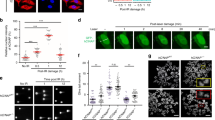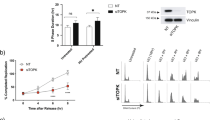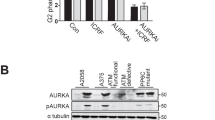Abstract
The promyelocytic leukaemia (PML) gene is translocated in most acute promyelocytic leukaemias and encodes a tumour suppressor protein. PML is involved in multiple apoptotic pathways and is thought to be pivotal in γ irradiation-induced apoptosis. The DNA damage checkpoint kinase hCds1/Chk2 is necessary for p53-dependent apoptosis after γ irradiation. In addition, γ irradiation-induced apoptosis also occurs through p53-independent mechanisms, although the molecular mechanism remains largely unknown. Here, we report that hCds1/Chk2 mediates γ irradiation-induced apoptosis in a p53-independent manner through an ataxia telangiectasia-mutated (ATM)–hCds1/Chk2–PML pathway. Our results provide the first evidence of a functional relationship between PML and a checkpoint kinase in γ irradiation-induced apoptosis.
This is a preview of subscription content, access via your institution
Access options
Subscribe to this journal
Receive 12 print issues and online access
$209.00 per year
only $17.42 per issue
Buy this article
- Purchase on Springer Link
- Instant access to full article PDF
Prices may be subject to local taxes which are calculated during checkout





Similar content being viewed by others
References
de The, H. et al. The PML-RAR α fusion mRNA generated by the t(15;17) translocation in acute promyelocytic leukemia encodes a functionally altered RAR. Cell 66, 675–684 (1991).
Goddard, A. D., Borrow, J., Freemont, P. S. & Solomon, E. Characterization of a zinc finger gene disrupted by the t(15;17) in acute promyelocytic leukemia. Science 254, 1371–1374 (1991).
Kakizuka, A. et al. Chromosomal translocation t(15;17) in human acute promyelocytic leukemia fuses RAR α with a novel putative transcription factor, PML. Cell 66, 663–674 (1991).
Mu, Z. M., Chin, K. V., Liu, J. H., Lozano, G. & Chang, K. S. PML, a growth suppressor disrupted in acute promyelocytic leukemia. Mol. Cell. Biol. 14, 6858–6867 (1994).
Mu, Z. M., Le, X. F., Vallian, S., Glassman, A. B. & Chang, K. S. Stable overexpression of PML alters regulation of cell cycle progression in HeLa cells. Carcinogenesis 18, 2063–2069 (1997).
Le, X. F., Vallian, S., Mu, Z. M., Hung, M. C. & Chang, K. S. Recombinant PML adenovirus suppresses growth and tumorigenicity of human breast cancer cells by inducing G1 cell cycle arrest and apoptosis. Oncogene 16, 1839–1849 (1998).
He, D. et al. Adenovirus-mediated expression of PML suppresses growth and tumorigenicity of prostate cancer cells. Cancer Res. 57, 1868–1872 (1997).
Wang, Z. G. et al. Role of PML in cell growth and the retinoic acid pathway. Science 279, 1547–1551 (1998).
Zhong, S. et al. A role for PML and the nuclear body in genomic stability. Oncogene 18, 7941–7947 (1999).
Wang, Z. G. et al. PML is essential for multiple apoptotic pathways. Nature Genet. 20, 266–272 (1998).
Quignon, F. et al. PML induces a novel caspase-independent death process. Nature Genet. 20, 259–265 (1998).
Elledge, S. J. Cell cycle checkpoints: preventing an identity crisis. Science 274, 1664–1672 (1996).
Matsuoka, S., Huang, M. & Elledge, S. J. Linkage of ATM to cell cycle regulation by the Chk2 protein kinase. Science 282, 1893–1897 (1998).
Brown, A. L. et al. A human Cds1-related kinase that functions downstream of ATM protein in the cellular response to DNA damage. Proc. Natl Acad. Sci. USA 96, 3745–3750 (1999).
Hirao, A. et al. DNA damage-induced activation of p53 by the checkpoint kinase Chk2. Science 287, 1824–1827 (2000).
Chehab, N. H., Malikzay, A., Appel, M. & Halazonetis, T. D. Chk2/hCds1 functions as a DNA damage checkpoint in G(1) by stabilizing p53. Genes Dev. 14, 278–288 (2000).
Shieh, S. Y., Ahn, J., Tamai, K., Taya, Y. & Prives, C. The human homologs of checkpoint kinases Chk1 and Cds1 (Chk2) phosphorylate p53 at multiple DNA damage-inducible sites. Genes Dev. 14, 289–300 (2000); erratum in Genes Dev. 14, 750 (2000).
Ruiter, G. A., Zerp, S. F., Bartelink, H., van Blitterswijk, W. J. & Verheij, M. Alkyl-lysophospholipids activate the SAPK/JNK pathway and enhance radiation-induced apoptosis. Cancer Res. 59, 2457–2463 (1999).
Merritt, A. J., Allen, T. D., Potten, C. S. & Hickman, J. A. Apoptosis in small intestinal epithelial from p53-null mice: evidence for a delayed, p53-independent G2/M-associated cell death after γ-irradiation. Oncogene 14, 2759–2766 (1997).
Strasser, A., Harris, A. W., Jacks, T. & Cory, S. DNA damage can induce apoptosis in proliferating lymphoid cells through p53-independent mechanisms inhibitable by Bcl-2. Cell 79, 329–339 (1994).
Tamura, T. et al. An IRF-1-dependent pathway of DNA damage-induced apoptosis in mitogen-activated T lymphocytes. Nature 376, 596–599 (1995).
Bartek, J., Falck, J. & Lukas, J. CHK2 kinase — a busy messenger. Nature Rev. Mol. Cell Biol. 2, 877–886 (2001).
Lee, J. S., Collins, K. M., Brown, A. L., Lee, C. H. & Chung, J. H. hCds1-mediated phosphorylation of BRCA1 regulates the DNA damage response. Nature 404, 201–204 (2000).
Fagioli, M. et al. Alternative splicing of PML transcripts predicts co-expression of several carboxy-terminally different protein isoforms. Oncogene 7, 1083–1091 (1992).
Nason-Burchenal, K. et al. Interferon augments PML and PML/RAR α expression in normal myeloid and acute promyelocytic cells and cooperates with all-trans retinoic acid to induce maturation of a retinoid-resistant promyelocytic cell line. Blood 88, 3926–3936 (1996).
Guidez, F. et al. Reduced retinoic acid-sensitivities of nuclear receptor corepressor binding to PML- and PLZF-RARα underlie molecular pathogenesis and treatment of acute promyelocytic leukemia. Blood 91, 2634–2642 (1998).
Bartkova, J. et al. Chk2 tumour suppressor protein in human spermatogenesis and testicular germ-cell tumours. Oncogene 20, 5897–5902 (2001).
Lukas, C. et al. DNA damage-activated kinase Chk2 is independent of proliferation or differentiation yet correlates with tissue biology. Cancer Res. 61, 4990–4993 (2001).
Falck, J., Mailand, N., Syljuasen, R. G., Bartek, J. & Lukas, J. The ATM–Chk2–Cdc25A checkpoint pathway guards against radioresistant DNA synthesis. Nature 410, 842–847 (2001).
Wu, X., Webster, S. R. & Chen, J. Characterization of tumor-associated Chk2 mutations. J. Biol. Chem. 276, 2971–2974 (2000).
Ward, I. M., Wu, X. & Chen, J. Threonine 68 of Chk2 is phosphorylated at sites of DNA strand breaks. J. Biol. Chem. 276, 47755–47758 (2001).
Sugimoto, K. et al. Frequent mutations in the p53 gene in human myeloid leukemia cell lines. Blood 79, 2378–2383 (1992).
Wolf, D. & Rotter, V. Major deletions in the gene encoding the p53 tumour antigen cause lack of p53 expression in HL-60 cells. Proc. Natl Acad. Sci. USA 82, 790–794 (1985).
Gotoh, T., Oyadomari, S., Mori, K. & Mori, M. Nitric oxide-induced apoptosis in RAW 264.7 macrophages is mediated by endoplasmic reticulum stress pathway involving ATF6 and CHOP. J. Biol. Chem. 277, 12343–12350 (2002).
Guidarelli, A., Clementi, E., De Nadai, C., Bersacchi, R. & Cantoni, O. TNFα enhances the DNA single-strand breakage induced by the short-chain lipid hydroperoxide analogue tert-butylhydroperoxide through ceramide-dependent inhibition of complex III followed by enforced superoxide and hydrogen peroxide formation. Exp. Cell Res. 270, 56–65 (2001).
Orengo, G. et al. Potentiation of topoisomerase I and II inhibitors cell killing by tumour necrosis factor: relationship to DNA strand breakage formation. Jpn J. Cancer Res. 83, 1132–1136 (1992).
Zhong, S. et al. Promyelocytic leukemia protein (PML) and Daxx participate in a novel nuclear pathway for apoptosis. J. Exp. Med. 191, 631–640 (2000).
Bell, D. W. et al. Heterozygous germ line hCHK2 mutations in Li-Fraumeni syndrome. Science 286, 2528–2531 (1999).
Guo, A. et al. The function of PML in p53-dependent apoptosis. Nature Cell Biol. 2, 730–736 (2000).
Cogswell, J. P., Brown, C. E., Bisi, J. E. & Neill, S. D. Dominant-negative polo-like kinase 1 induces mitotic catastrophe independent of cdc25C function. Cell Growth Differ 11, 615–623 (2000).
Acknowledgements
We thank M. Alcalay for the PML vector; J. H. Chung for the V5–hCds1/Chk2(WT, KD) constructs and anti-hCds1/Chk2 antibodies; Y. Shiloh for the AT cells; Y. Xu and C. Combs for help with confocal microscopy; J. P. Cogswell and C. E. Brown for help with recombinant adenovirus production.
Author information
Authors and Affiliations
Corresponding author
Ethics declarations
Competing interests
The authors declare no competing financial interests.
Rights and permissions
About this article
Cite this article
Yang, S., Kuo, C., Bisi, J. et al. PML-dependent apoptosis after DNA damage is regulated by the checkpoint kinase hCds1/Chk2. Nat Cell Biol 4, 865–870 (2002). https://doi.org/10.1038/ncb869
Received:
Revised:
Accepted:
Published:
Issue Date:
DOI: https://doi.org/10.1038/ncb869
This article is cited by
-
Multipronged regulation of autophagy and apoptosis: emerging role of TRIM proteins
Cellular & Molecular Biology Letters (2024)
-
Filamentous nuclear actin regulation of PML NBs during the DNA damage response is deregulated by prelamin A
Cell Death & Disease (2022)
-
PML: Regulation and multifaceted function beyond tumor suppression
Cell & Bioscience (2018)
-
Functions and dys-functions of promyelocytic leukemia protein PML
Rendiconti Lincei. Scienze Fisiche e Naturali (2018)
-
CHK2 stability is regulated by the E3 ubiquitin ligase SIAH2
Oncogene (2016)



